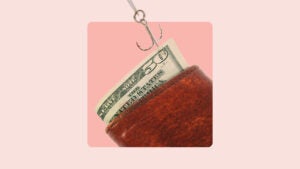Car insurance for high-risk drivers in New Jersey

If you have infractions on your driver record in the Garden State, such as speeding tickets, at-fault accidents, or a DUI, you may need to look for high-risk coverage from a New Jersey insurance company. Affordable insurance for high-risk drivers can take a little work to find, but by shopping around, you may find affordable high-risk car insurance in New Jersey. Bankrate’s insurance editorial team reviewed average rates from a range of major and regional insurers to help you find the best insurance if you are considered high-risk in New Jersey.
Rates for high-risk car insurance in New Jersey
New Jersey car insurance rates are highly personalized. Your insurer considers multiple factors when determining your rate, including your driving record. Finding the best auto insurance for you at the most affordable rate means considering these factors and shopping around. Previous convictions for speeding, at-fault accidents and DUIs will likely affect your rate. Age can also play a role, with teen drivers generally paying relatively high rates for their coverage compared to other age groups. Because rates are unique to every individual, the best car insurance company for your neighbor may not be the best one for your needs.
Below, Bankrate showcases how different incidents impact auto insurance rates across companies in New Jersey, based on average premium data from Quadrant Information Services.
Rates after a speeding ticket
A high-risk driver in New Jersey can expect their insurance rates to increase, although the amount will vary by company. Drivers can also face fines between $85 to $260 depending on how much in excess of the speed limit the driver was traveling and where the infraction took place. Repeat offenders could be jailed, have their vehicle impounded and have their license suspended or revoked. Though not everyone will need high-risk auto insurance in NJ after one speeding ticket on their motor vehicle record, repeat offenders may find limited insurance options and need to resort to high-risk insurance coverage.
The table below shows the average yearly rate for full coverage before and after a speeding ticket conviction in New Jersey by company, as well as the average percent increase in premiums following a conviction, according to Quadrant Information Services as of January 2025. Selective, Travelers, NJM, Plymouth Rock and Geico are some of the cheapest auto insurance providers in New Jersey for high-risk drivers, on average, but smaller regional insurers may also offer competitive rates.
New Jersey average annual full coverage premium
| Car insurance company | Rate before a speeding ticket conviction | Rate after a speeding ticket conviction | % increase |
| Selective | $1,543 | $1,543 | 0% |
| Travelers | $1,683 | $2,093 | 24% |
| NJM | $1,881 | $2,142 | 14% |
| Plymouth Rock | $2,023 | $2,371 | 17% |
| Geico | $2,490 | $2,490 | 0% |
Rates after an at-fault accident
An at-fault collision is when a driver is responsible for causing personal injury or property damage to another party’s property, or one that results in injuries or damage to their own passengers and vehicle. After an at-fault collision, a high-risk driver label is possible, which can increase insurance premiums. It may also lead to the loss of any safe driver discounts currently on a policy. Subsequent at-fault collisions may result in drivers needing to purchase high-risk car insurance in New Jersey if their current insurer or other companies deem them too risky to insure with a standard policy.
Compare the rates below for average annual premiums before and after an at-fault collision.
New Jersey average annual full coverage premium
| Car insurance company | Rate before an at-fault accident | Rate after an at-fault accident | % increase |
| NJM | $1,881 | $2,015 | 7% |
| Selective | $1,543 | $2,397 | 55% |
| National General | $2,056 | $2,524 | 23% |
| Travelers | $1,683 | $2,542 | 51% |
| Plymouth Rock | $2,023 | $2,936 | 45% |
Rates after a DUI
A DUI is one of the most serious offenses that can lead to a high-risk driver label. The table below shows before and after average annual rates, with a minimum increase of 14 percent from NJM after a DUI conviction is factored in. If a driver’s license is suspended under New Jersey law after a DUI, they may only be eligible for high-risk auto insurance in New Jersey.
New Jersey average annual full coverage premium
| Car insurance company | Rate before a DUI conviction | Rate after a DUI conviction | % increase |
| NJM | $1,881 | $2,142 | 14% |
| Plymouth Rock | $2,023 | $2,467 | 22% |
| Travelers | $1,683 | $2,847 | 69% |
| Selective | $1,543 | $2,950 | 91% |
| Esurance | $2,644 | $3,403 | 29% |
Rates for teen drivers
Even with a clean driving record, most insurance companies consider teen drivers a high risk until they gain enough years of experience behind the wheel. As teens get older and continue to practice safe driving habits, rates usually decrease, although there is no guarantee of lower rates. The table below shows the average annual cost of car insurance for married couples with and without a 16-year-old driver included on the policy.
New Jersey average annual full coverage premium
| Car insurance company | Rate without a 16-year-old insured | Rate with a 16-year-old insured* | % increase |
| NJM | $1,881 | $2,362 | 26% |
| Geico | $2,490 | $3,050 | 22% |
| Selective | $1,543 | $3,723 | 141% |
| Farmers | $1,867 | $3,995 | 114% |
| Travelers | $1,683 | $4,069 | 142% |
Teens are usually listed as drivers on their parents’ policy. However, that could change if they become a high-risk driver with a speeding ticket, at-fault accident or DUI on their record. If that happens, they may not be renewed and have to pursue high-risk car insurance elsewhere.
What makes you high risk for auto insurance?
A high-risk driver is someone that a car insurance company may designate as more likely to file costly claims. Some behaviors that may flag you as high risk include speeding, drinking and driving or driving distracted, such as texting while driving.
Bankrate’s high-risk driver profiles account for policyholders who had a lapse in coverage in the past, teen drivers and those who have one speeding ticket conviction, at-fault accident or DUI conviction on their record.
How to lower your rate if you are a high-risk driver
Insurance rates may remain high as long as the points still show on your driving record. In the case of a DUI, expect to pay higher rates for at least 10 years. To find cheap car insurance in NJ for bad drivers, consider the following tactics:
- Shop around and switch car insurance providers if another insurer is able to offer you a better rate.
- Ask for discounts based on your unique profile, such as those for students, for military or corporate affiliation or for having a newer car.
- Raise your deductibles. Assuming a greater degree of financial responsibility for future claims can reduce your premiums.
- Compare car insurance quotes each year before your coverage renews to ensure you are still getting the best price.
Look for a carrier that offers accident forgiveness. While this will not lower rates following a recent incident, you may save yourself from increased rates in the future should one new at-fault accident occur.
Frequently asked questions
Methodology
Bankrate utilizes Quadrant Information Services to analyze January 2025 rates for all ZIP codes and carriers in all 50 states and Washington, D.C. Rates are weighted based on the population density in each geographic region. Quoted rates are based on a single, 40-year-old male and female driver with a clean driving record, good credit and the following full coverage limits:
- $100,000 bodily injury liability per person
- $300,000 bodily injury liability per accident
- $50,000 property damage liability per accident
- $100,000 uninsured motorist bodily injury per person
- $300,000 uninsured motorist bodily injury per accident
- $500 collision deductible
- $500 comprehensive deductible
To determine minimum coverage limits, Bankrate used minimum coverage that meets each state’s requirements. Our base profile drivers own a 2023 Toyota Camry, commute five days a week and drive 12,000 miles annually.
These are sample rates and should only be used for comparative purposes.
Incidents: Rates were calculated by evaluating our base profile with the following incidents applied: clean record (base), at-fault accident, single speeding ticket and single DUI conviction.
Teens: Rates were determined by adding a 16- or 17-year-old teen to their 40-year-old married parents’ policy. The rates displayed reflect the total cost of a driver this age added to their parents’ policy.
You may also like

5 ways a financial advisor can help you reach your goals in 2024

Recourse Loans: What To Know Before You Borrow

Rideshare insurance: What is it and who needs it?



